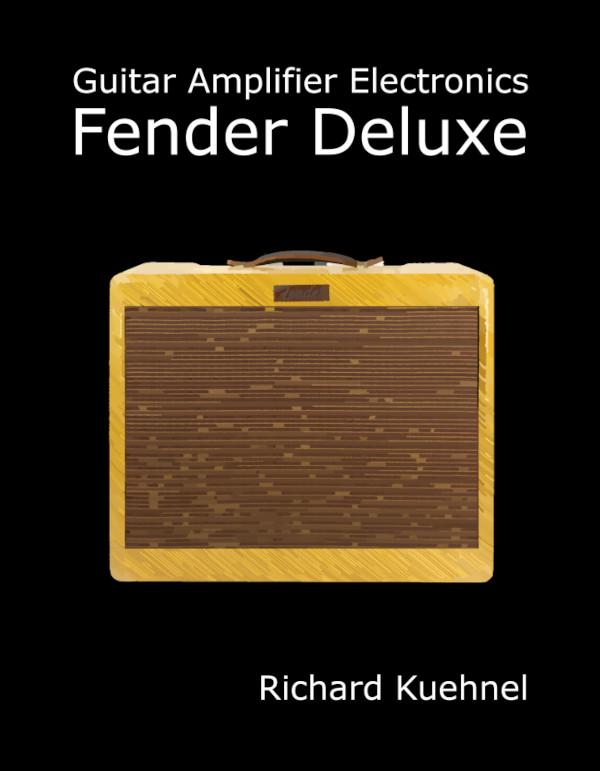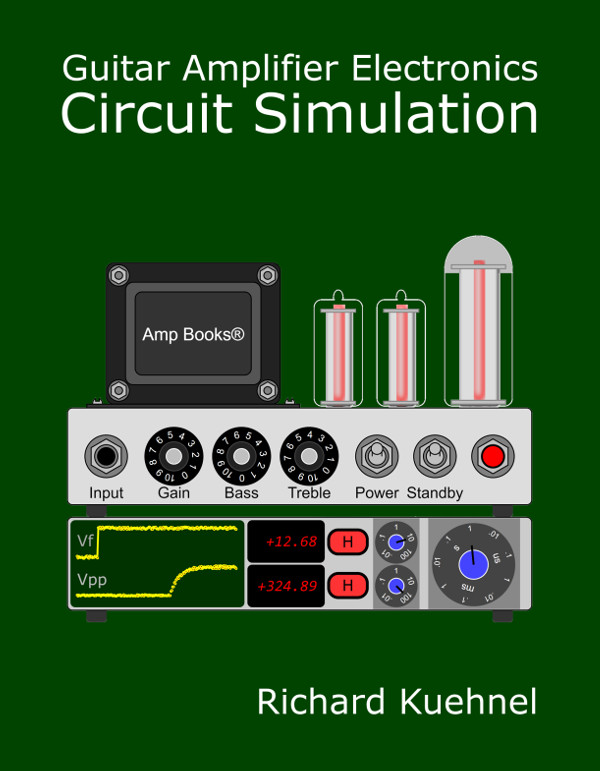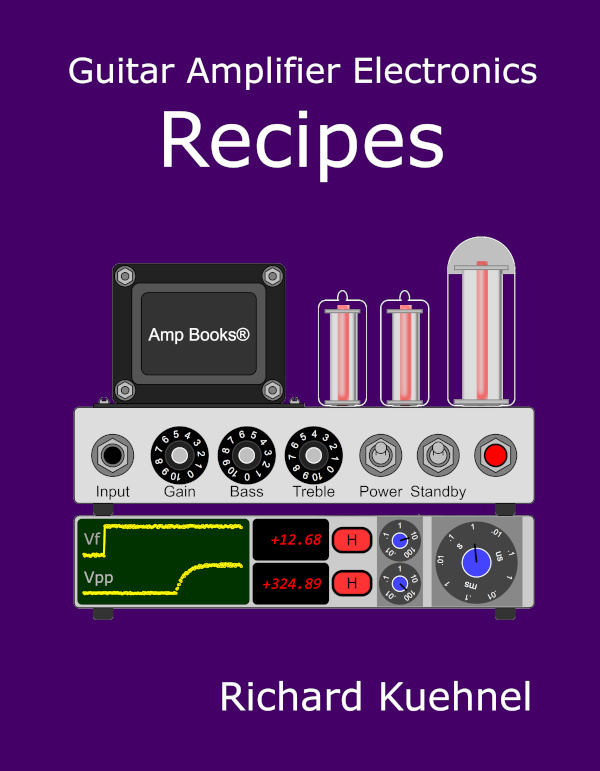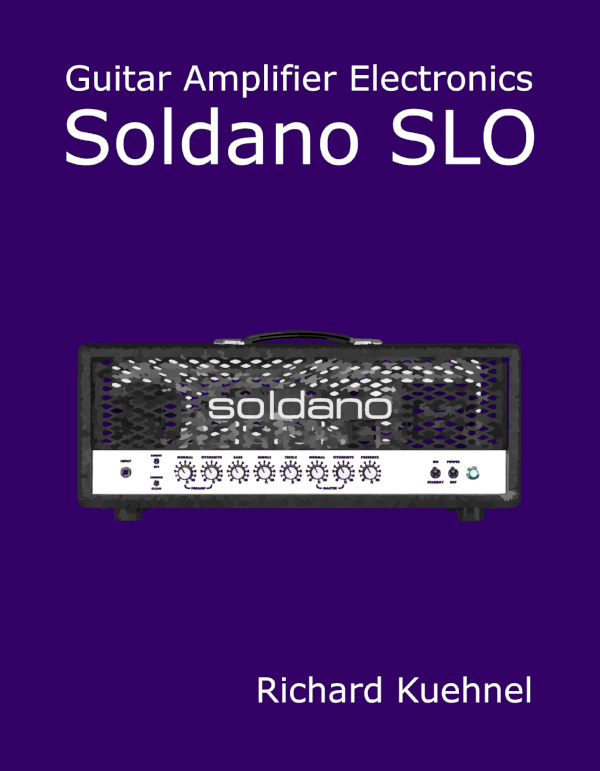Noise in Guitar Amplifier Preamps
Noise is of particular concern in a preamp because it mixes with the low-level guitar signal and gets amplified by downstream stages. It can be particularly annoying when the guitar player is not playing and the amp sits idle in a quiet room.
Microphonic Noise
Microphonic noise is more common in pentodes than in triodes, and is due to mechanical vibration of the tube, either from vibration passed to the tube via its socket or from the impact of sound waves on its glass or metal envelope. The vibration causes variations in the relative spacings between the tube's electrodes which subsequently affects the space charge within the tube. Since the vibration comes from sound waves at audio frequencies, they can be heard in the amplifier output. Austin Eastman suggests the following cure:1
"Mounting of the entire amplifier on rubber cushions and, if necessary, separate mounting of the tube sockets will reduce the probability of microphonics."
For guitar players, microphonic noise can be controlled by careful placement of the amplifier relative to strong sources of vibration. Setting the amp next to the kick drum is not advisable.
Thermal Noise
Current in a conductor is not a smooth, continuous phenomenon. It is the summation of the movements of a huge number of individual electrons, each fluctuating wildly. The individual movements of negatively-charged electrons, which can be called noise currents, average out to a net flow in one direction or the other that we know as the "current" in a conductor. (Perhaps to be more accurate we should use "net current" or "average current" to describe what we know as current that is subject to Ohm's Law.)

|
Guitar Amplifier Electronics: Fender Deluxe - from TV front to narrow panel to brownface to blackface Reverb |
When the conductor is in thermal equilibrium, thereby maintaining a constant temperature, the noise generated by the individual movements of the electrons is referred to as thermal noise, resistance noise, or Johnson noise. The thermal noise RMS voltage in a resistor can be calculated using our
Theoretically a physically large, well-cooled resistor produces less noise than a hot, quarter-watt resistor in the same application. The difference, however, is not very significant in a guitar amp because the thermal noise RMS voltage is proportional to the square root of the temperature in degrees Kelvin. Temperature in Kelvin is measured relative to absolute zero and equal to 273 degrees plus the temperature in Celsius. When a resistor's temperature increases from that of melting ice (273 degrees Kelvin) to that of boiling water (373 Kelvin), representing a rather extreme temperature rise, the noise voltage increases by only 17 percent. Cryogenic cooling would certainly have an effect, but there are more practical ways to reduce thermal noise in a preamp, primarily by a well-designed first stage, as will be seen.
The noise voltage in any two one-Hertz-wide frequency bands is the same, so the thermal noise spectrum is completely flat, having the same power level at bass frequencies as it does at treble frequencies. This is often called white noise. Noise increases with bandwidth, so when the bandwidth of a preamp is narrowed, noise is attenuated.

|
Guitar Amplifier Electronics: Basic Theory - master the basics of preamp, power amp, and power supply design. |
The effect of amplifier bandwidth can be easily observed by cranking the volume up to maximum and listening to the resulting white, thermal noise. Turning down the bass control reduces low-frequency rumble, transforming the noise into a softer, high-frequency hiss. Turning down the treble control eliminates the piercing, high-frequency components and reduces the overall noise level even further.
The noise voltage increases when the resistor value increases. A 100kΩ resistor produces more than 3 times the noise voltage of a 10kΩ resistor.
Tube Noise
Because the space current between the cathode and the plate consists of individual electrons, it is not smooth and continuous. Instead it fluctuates, producing so-called shot noise.
When space current is space-charge limited,2 shot noise can be calculated in terms of absolute temperature in Kelvin, Boltzmann's constant, a space-charge reduction factor, etc.3 For a preamp triode, however, it is more conveniently expressed in terms of an equivalent noise resistance Req connected between the grid and the cathode with a value approximately equal to4

where gm is the transconductance in siemens ("mhos" in old tube data sheets). Other types of noise are created by random fluctuations within a vacuum tube. These include partition noise, which is caused by random variations in the proportion of total cathode current divided between the plate and the screen of a pentode. Grid noise is caused by random variations in the number of electrons passing adjacent to a grid and gas noise is caused by random variations due to the creation of positive ions. Random variations in the rate of production of secondary electrons also produces noise. In general, the noise produced in a pentode is 3 to 5 times greater than in a triode for the same amount of amplification.5.

|
Fundamentals of Guitar Amplifier System Design - design your amp using a structured, professional methodology. |
First Stage Dominance over Noise Figure
The noise factor of a component is defined as the signal-to-noise ratio (SNR) at the circuit's input divided by the SNR at the output. A circuit's noise figure, which is often more convenient to use, is simply the noise factor expressed in dB. A perfect, noiseless voltage amplification stage has a noise factor equal to 1 and a noise figure equal to 0dB.
Consider two cascaded preamp stages, each with a gain and noise factor.

The overall noise factor is equal to

It is independent of the gain of the second stage. Moreover, for a typical high-gain first stage the noise factor of the second stage becomes insignificant because of G1 in the denominator of the second term. The noise factor for a third or fourth stage is even less significant. Thermal noise generated in the first stage generally sets noise conditions for the entire amplifier.

|
Guitar Amplifier Electronics: Circuit Simulation - know your design works by measuring performance at every point in the amplifier. |
As an example of less-than-ideal noise design, consider the first stage of the Wards Airline GDR-9012A.

Even with the volume control cranked up to maximum there is a slight amount of signal attenuation prior to voltage amplification, which reduces the signal-to-noise ratio. Lower volume settings degrade SNR further. It is better to place the volume control after the first stage, as is ubiquitous in guitar amp design.

In general, the preamp signal chain begins with a healthy zig of voltage amplification followed by a zag attenuation. A zigzag pattern of amplification and attenuation with a gradually increasing overall signal level is a common paradigm in guitar amplifier system design.6
References
1Austin Eastman, Fundamentals of Vacuum Tubes, (New York: McGraw-Hill, 1941), p. 295.
2Richard Kuehnel, Guitar Amplifier Electronics: Basic Theory, (Seattle: Amp Books, 2018), p. 35.
3Reference Data for Radio Engineers, 5th Ed., H.P. Westman, ed., (Indianapolis: Howard W. Sams, 1969), p. 16-11.
4F. Langford-Smith, ed., Radiotron Designer's Handbook, 4th ed., (Harrison: RCA, 1953), p.783.
5Frederick Terman and Joseph Pettit, Electronic Measurements, 2nd ed., (New York: McGraw-Hill, 1952), pp. 356-357.
6Richard Kuehnel, Fundamentals of Guitar Amplifier System Design, (Seattle: Amp Books, 2019), p. 139.

|
From system design concepts to individual stage operation, an all-new examination of Bassman electronics. |


